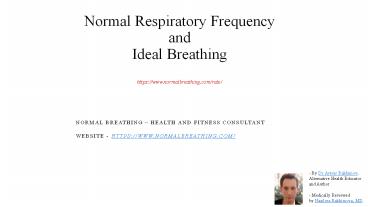Normal Respiratory Frequency - PowerPoint PPT Presentation
Title:
Normal Respiratory Frequency
Description:
Normal Breathing provides the best health and Fitness consultat service in Canada with Experience. they have many solution of the health and fitness. – PowerPoint PPT presentation
Number of Views:18
Title: Normal Respiratory Frequency
1
Normal Respiratory Frequency and Ideal
Breathinghttps//www.normalbreathing.com/rate/
Normal Breathing Health and Fitness
consultant Website - https//www.normalbreathing.c
om/
- By Dr. Artour Rakhimov, Alternative Health
Educator and Author- Medically Reviewed
by Naziliya Rakhimova, MD
2
- https//youtu.be/F_6sM50bGDQ
- Definition. Respiratory rate (also known as
ventilation rate, respiration rate, breathing
rate, pulmonary ventilation rate, breathing
frequency, and respiratory frequency or Rf) the
number of breaths a person takes during one
minute. It is usually measured at rest while
sitting. - Medical research suggests that respiration
rate is the marker of pulmonary dysfunction.
Patients breathe more often at rest in advance of
a large number of chronic health conditions. This
website has scientific references related to
increased respiratory rates for adults with
cancer patients, cystic fibrosis, heart disease,
asthma, diabetes, COPD and many other conditions.
https//www.normalbreathing.com/
3
What is the normal respiratory Rate?
- Medical textbooks suggest that the
normal respiratory rate for adults is only 12
breaths per minute at rest. Older textbooks often
provide even smaller values (e.g., 8-10 breaths
per minute). Most modern adults breathe much
faster (about 15-20 breaths per minute) than
their normal breathing frequency. - The respiratory rates in the sick persons are
usually higher, generally about 20 breaths/min or
more. This site quotes numerous studies that
testify that respiratory rates in terminally sick
people with cancer, HIV-AIDS, cystic fibrosis and
other conditions is usually over 30 breaths/min.
https//www.normalbreathing.com/
4
What are the effects of increased respiratory
rates?
- When we breathe more than the medical norm, we
lose CO2 and reduce body oxygenation due to
vasoconstriction and the suppressed Bohr effect
caused by hypocapnia (CO2 deficiency). Hence,
over breathing leads to reduced cell oxygenation,
while slower and easier breathing (with lower
respiratory rates) improves cell-oxygen content.
Groups of children Their ages Normal respiration rates
Newborns and infants Up to 6 months old 30-60 breaths/min
Infants 6 to 12 months old 24-30 breaths/min
Toddlers and children 1 to 5 years old 20-30 breaths/min
Children 6 to 12 years 12-20 breaths/min
https//www.normalbreathing.com/
5
- More about respiratory frequency and body
oxygenation - From a physiological viewpoint, the body-oxygen
test is a more meaningful and important DIY test,
than ones breathing frequency. If you have less
than 20 s of oxygen in the morning (when you wake
up), you are likely to have health problems. - Ideal Respiration Rate
- The ideal respiration frequency at rest for
maximum possible brain- and body-oxygen levels
corresponds to the automatic or unconscious
breathing with only X breaths/min (find out this
exact number X in the bonus content).
https//www.normalbreathing.com/
6
- Thank You
https//www.normalbreathing.com/































